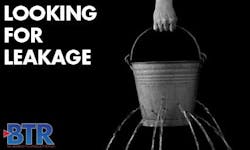The good news is that the price of failure is a bit lower (poor or unsuccessful phone calls is a less serious threat than degraded airplane communications). Regardless, it is a quality of experience issue that can’t be discounted, especially considering the continued growth of LTE and the nascent move to LTE-Advanced, which is starting. “I would say it’s becoming significant, and I think over time will become increasingly significant,” said Ken Couch, the director of marketing for ComSonics.
There are several ways in which the aeronautical and LTE situations differ. First and most obviously is location: The aeronautical channels are in the 108-137 MHz range, while LTE inhabits the 698-806 MHz frequencies, according to an eBook written by BTR contributor and Cisco Technical Leader Ron Hranac and posted by BTR last week. A second difference is that the LTE signals are in the digital domain, while at least some transmissions in the aeronautical band remain in the analog domain.
Much of the attention to date has been on the impact of leaked cable signals on LTE communications. A related problem - in fact, the exact reverse - is emerging: LTE signals leaking into poorly shielded or unterminated cable plant can impact services offered to subscribers. “It is most notable in the house because the cell - the transmitter of the signals - normally is close to the cable infrastructure,” Couch said.
At the end of the day, ingress into cable plant may help shoot LTE leakage to the top of the agenda for operators. What is entering cable plant is as big a deal as what is exiting. “Operators absolutely are having problems with it,” said Trilithic Senior Product Manager Mark Darragh. “Some cable operators are dropping 6 MHz channels because of LTE signals that are getting in.”
The LTE leakage challenge is more complex than it is in the aeronautical frequencies because handsets and tablets are portable. That makes measurements of the impact of leakage on a particular phone or tablet - or on the cable plant next to which they are blasting away - highly variable.
Currently, the rules state that leakage in the aeronautical band cannot exceed 20 microvolts (µV) per meter measured at 3 meters. In the LTE band, the limit is 150 µV at the same 3 meters. There also is a lesser known "harmful interference clause" that is broader. "It says that anything that causes damage is the cable industry's responsibility to clean up," Darragh said
It is not surprising that use of new frequencies and the transition from analog to digital and the mobile nature of the LTE end devices make the old rules and limits antiquated. “The old egress limits don’t apply [in LTE] and are not a good measure of what is acceptable or unacceptable from a 'good neighbor' point of view,” said Paul Denisowski, an application engineer for Rohde & Schwarz.
More targeted guidance may be on its way. Daniel Babeux, the vice president of business development for broadband networks at Effigis Geo-Solutions, said in August 2012 the FCC issued a Notice of Proposed Rulemaking that proposed changes to permissible leakage levels. The proposed limit for the spectrum above 216 MGz would be 13.1 microvolts per meter at 30 meters, Babeux said.
It is an ongoing process. Babeux said the cable industry, through the SCTE’s Network Operations Subcommittee (NSO) Working Group 1, which is chaired by Hranac, is participating in the FCC rulemaking process.
This is a challenge that is significant today and is likely to grow. At the field level, MSO and telco personnel generally work out issues on an informal basis: If the telco reports a leakage issue to the operator, it is taken care of in a cooperative manner. When the problems first emerged, the local telephone and cable technicians often didn’t know each other. Now, Denisowski said, relationships for the most part have been established. “I think we are past [the unfamiliarity] now,” he said.
Purpose-built gear that handles both the aeronautical and LTE use cases is also emerging. For instance, the new QAM Shadow from ComSonics, said Couch, is a small form factor device with self-contained antennas. The Seeker D from Trilithic, which measures in both areas, has been available for about a year, Barragh said. The CPAT FLEX from Effigis also offers dual measurement capabilities, Babeux said.
About the Author

